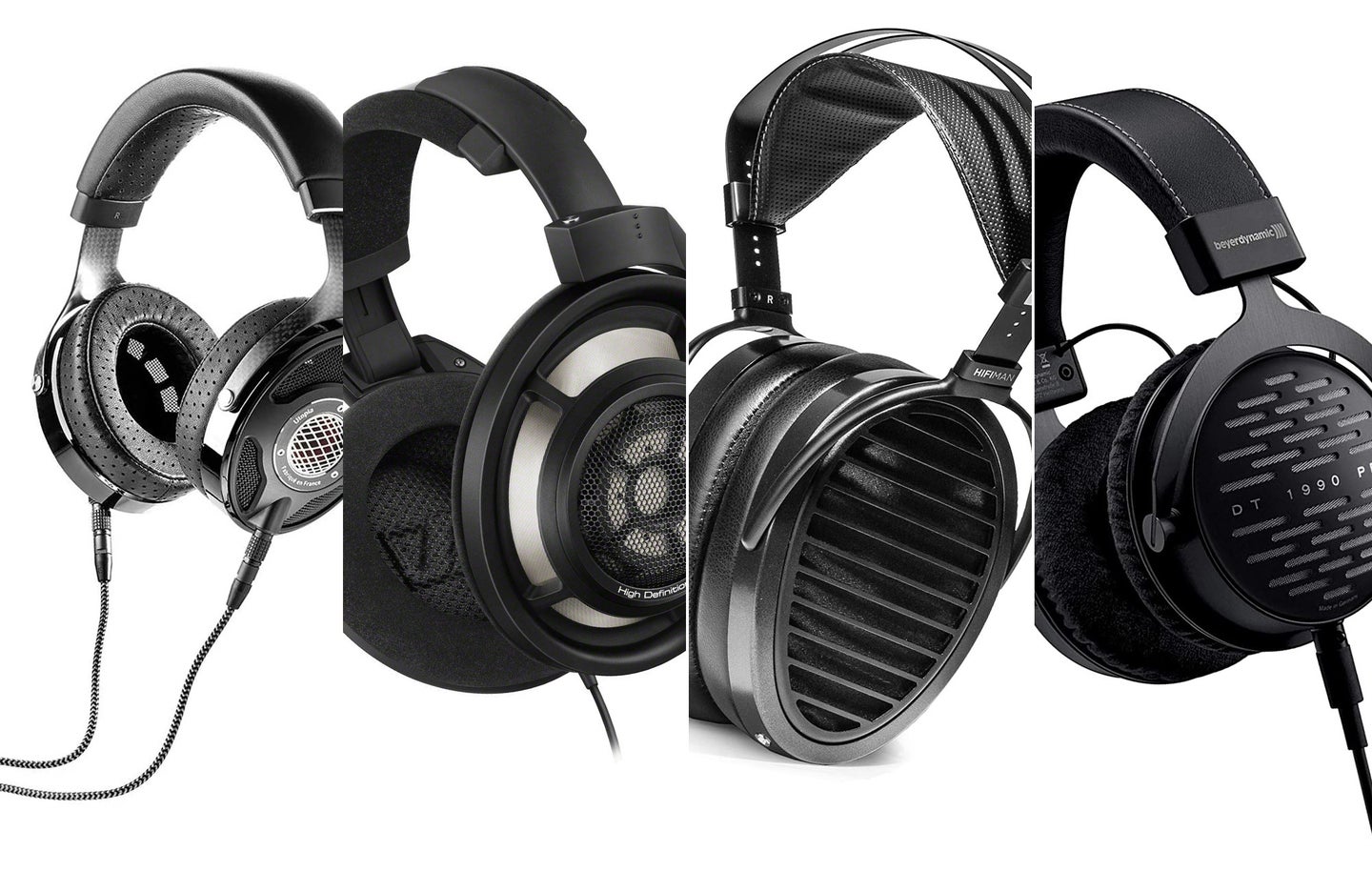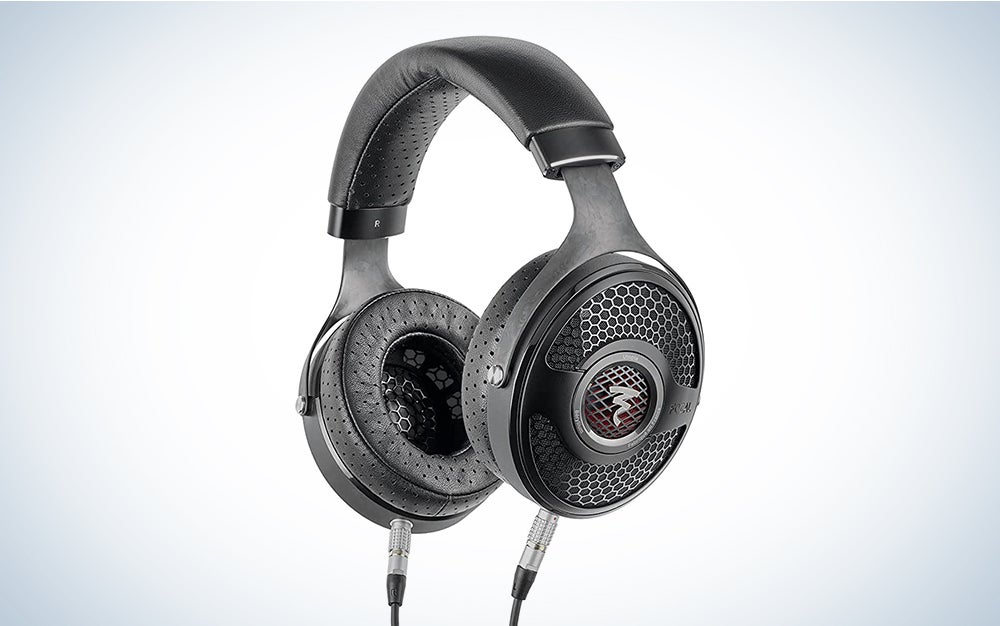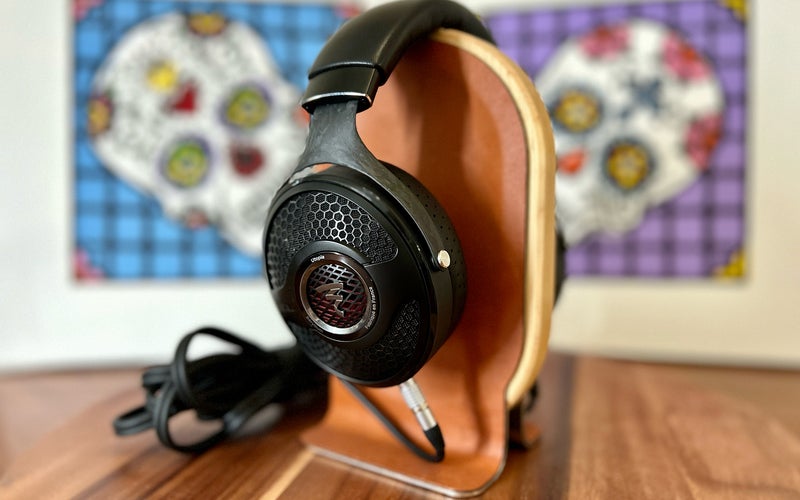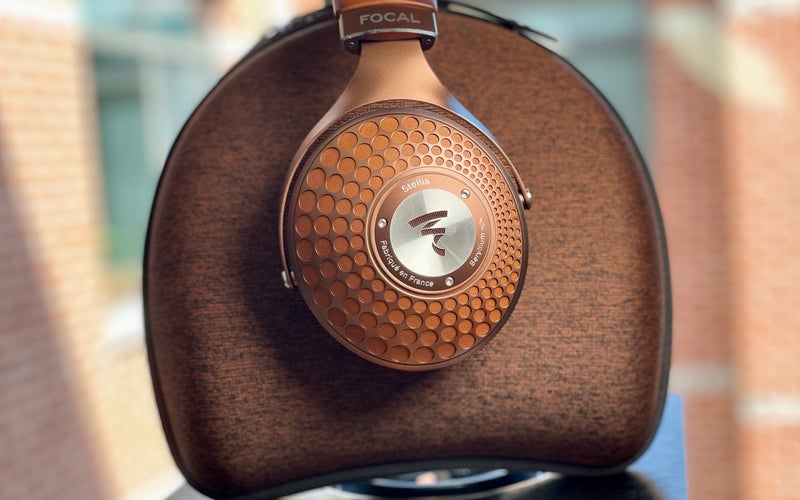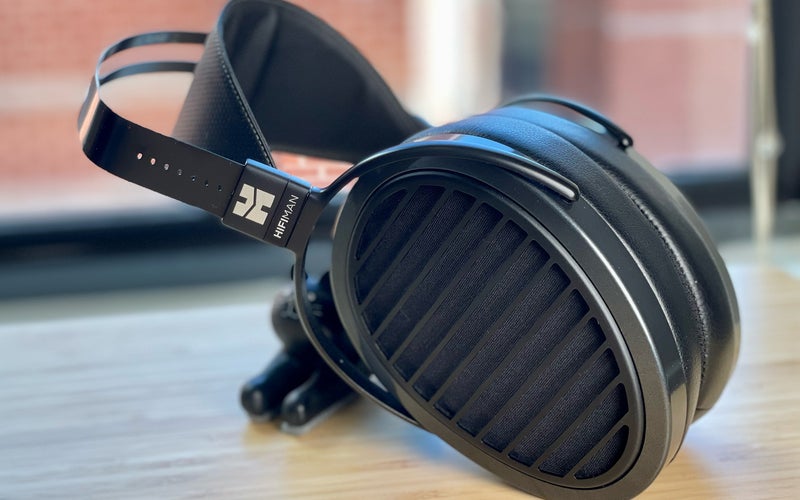We may earn revenue from the products available on this page and participate in affiliate programs. Learn more ›
For many people, headphones have become a necessity in their daily lives. As more workers settle into remote roles, headphones are becoming home-office staples for blocking out distractions and piping in colleagues. A growing number of content creators, from podcasters to musicians, rely on headphones to help them produce their best work in shared spaces. And, of course, some people just use them for pure transportive pleasure, as a means to decompress after the demands of the day. The best headphones provide an immersive aural escape, whether you’re bringing your entertainment along on your commute, fueling your workout, focusing at your desk, or just relaxing at home, luxuriating in your favorite songs.
- Best open-back: Focal Utopia 2022
- Best closed-back: Focal Stellia
- Best for audiophiles: Sennheiser HD 800 S
- Best planar-magnetic: HiFiMAN Arya Stealth Magnet Version
- Best noise-canceling: Sony WH-1000XM5
- Best for mixing: beyerdynamic DT 1990 Pro
How we chose the best headphones
We spend a lot of time at Popular Science musing over facts and figures, but music is probably a close second when it comes to what’s on our minds. With all our Slack sessions sharing song suggestions fresh in our memories, we started our list of the best headphones based on our personal experience with the best over-ear headphones. We then polled peers about their favorite headphones for music, parsed through critical reviews and user impressions, and narrowed it down to what we believe are headphones that can appeal to the widest range of listeners without pandering to any single type of tonality other than awesome.
The best headphones: Reviews & Recommendations
The best headphones will reproduce every nuance of your favorite songs, movies, podcasts, and game soundtracks with superior clarity, dynamics, and detail. It’s important to note, however, that there is no perfect headphone—just the headphone that’s perfect for you and what you listen to.
Some purists search for end-game neutrality, picking everything in their signal chain to preserve a linear, studio-grade frequency response. Others may get a reference headphone that responds well to EQing, etc. Then they use components—like the best digital audio converters and tube-driven amplifiers—to add “color” to this baseline. Still others want a specific tuning no matter what the source and buy a headphone known for the signature that matches their genre of choice. (What works best for opera, EDM, Americana, and black metal is rarely the exact same thing.) Here are some of our favorite choices for various scenarios, each category featuring both a price-no-object pick and budget alternatives:
Best open-back: Focal Utopia 2022
Tony Ware
Why it made the cut: If you’re looking to invest in blue-chip components, these are the best-of-the-best open-back headphones.
Specs
- Style: Open-back/over-ear
- Drivers: 40mm “M”-shaped beryllium dynamic
- Frequency response: 5 Hz–50 kHz
Pros
- Unrivaled fidelity
- Fit (and feel) like a glove
- Stunningly lifelike soundstage
Cons
- Price is out of reach for most
We’re kicking off our hot list with the undisputed cream of the crop, the best overall headphones: the instantly, enduringly iconic Focal Utopia. (Yes, it has a jaw-dropping $4,999 price tag to match. But stick with us because, price-wise, it’s all downhill from here!)
French manufacturer Focal built a reputation for producing some of the most beautiful and best-sounding speakers available. That tradition continued with the launch of the company’s portable pinnacle in 2016. Utopia—Focal’s flagship open-back, over-ear headphones—produced an astonishingly revealing, deep soundstage. Inside, a pair of 40mm beryllium “M”-shaped dome dynamic drivers took advantage of the precious metal’s extreme lightness and stiffness to produce a smooth, ultrawide frequency response reminiscent of Focal’s premium speaker drivers. (A note about beryllium: This metal is hazardous in certain forms and contexts but is generally considered safe inside headphones and speaker drivers. For more information, see Focal’s documentation outlining precautions for use.)
The Utopia immediately established itself as one of the top aspirational audiophile headphones thanks to engineering that suspended its angled drivers in an open-air chamber to achieve an open, lifelike sound stage and remarkable detail reproduction. Utopia’s cozy fenestrated lambskin earcups connected to the plush headband with a carbon fiber yoke to minimize both weight (490g) and acoustic coupling, allowing pairs to stay effortlessly on the head of proud owners who extolled their pleasure continuously for the last five years. In 2022, however, the Utopia underwent an aesthetic makeover and sonic refinement. The voice coil, previously all aluminum, is now a blend of 30% copper and 70% aluminum, while the interior grill is now curved to match the driver.
These changes increase the headphones’ durability and conscientiously tweak its tuning, slightly shelving treble without dulling clarity and slightly extending subbass without affecting cohesion. It all adds up to an incredible sound stage with stunning realism and an emphasis on revealing musicality rather than unforgiving transparency (check out the Sennheiser HD 800 S below for that). Neutral-warm with immaculate imaging, able to deliver the attack and decay of each note with authority, the Focal Utopia 2022 is the idyll ideal—impressive not because of its sheer power but because of its absolute prowess.
While the 80-ohm Utopia can play nice with most sources, experiencing every lithe, lightning-quick transient at its best requires you use a great balanced amp and feed these headphones a quality signal. A most synergistic option is the Naim Uniti Atom Headphone Edition (shown below topped by the now-discontinued Utopia 2020, a repackaging of the original Utopia with expanded accessories that is still a great buy at around $3,000). This amp/DAC/streaming music player supports Roon, TIDAL, Spotify, AirPlay 2, up to 32bit/384kHz via UPnP, etc., and features a dynamic voicing and presentation in lock-step with the pace, rhythm, and timing of any Utopia (especially when using the included balanced cable). If you’re looking for sonic solace, this pairing is pure bliss.

Utopias giving you sticker shock? We feel you. The Focal Clear Mg (for Magnesium, the driver’s material) is the company’s “entry-level” open-back at only $1,599, if you want to sample the company’s spacious dynamics. Suppose you’re just interested in dipping a pinkie toe rather than cannonballing into audiophile-oriented open-back headphones. Our top recommendation for headphones that punch well above their price point would be the Meze Audio 109 PRO, which uses a new beryllium-coated polymer + cellulose-carbon driver for a precision-driven high that comes on with a comfortable balance of euphoria and technicalities. Meanwhile, the Philips Fidelio X2HR, a $148 over-ear model, is adored by connoisseurs of high-performing budget headphones. As for a more affordable amp/R2R DAC that can drive anything (including the Utopia) with verve, the $599 HiFiMan EF400 is highly recommended.
Best closed-back: Focal Stellia
Tony Ware
Why it made the cut: For fans of closed-back headphones, flawless sound, and French fashion-forward styling, Stellia is a star performer.
Specs
- Style: Closed-back/over-ear
- Drivers: 40mm “M”-shaped beryllium dynamic
- Frequency response: 5 Hz–40 kHz
Pros
- Intimate soundstage with superior isolation
- Exquisite design and finishes
- Precise, controlled bass
Cons
- Heavy
Fans of Focal’s venerated Utopia headphones will find similar sonic gratification in the company’s Stellia headphones. This closed-back design offers two-thirds of Utopia’s outstanding soundstage (leaning more tall than wide). Like the Utopia, Stellia features light, rigid beryllium drivers (a material you can read about more above), which deliver a detailed, intimate sound profile. Transients are crisp, bass is warm yet defined. All of this comes with better isolation than the Stellia’s Utopian sibling (because, as you can see comparing the images above, there is an additional acoustic membrane beneath the Stellia’s grill.
Stellia’s headband and earcups are lined in designer leather and filled with memory foam, making them somewhat heavy. Still, the headband and yoke mechanical features are adapted from the Utopia, which informs their high comfort factor, regardless of the shape and size of the listener’s head.
These headphones look as gorgeous as they sound, with aluminum-accented full-grain leather and mocha and cognac finishes. Accessories include three detachable oxygen-free cables and a ¼-inch adapter, plus a form-fitting, padded, purse-like case. Everything is housed in a sturdy leatherette box.
Those interested in a more “affordable” sampling of Focal’s balance of bass extension and treble precision can pick up the Celestee, which features an “M”-shaped aluminum/magnesium driver, for only a grand.
If you prefer your headphones to cost less than a used car, the stylish, wood-finished Meze Audio 99 Classics over-ear, closed-back headphones only cost a few hundred. They will appeal to those who want efficient and non-fatiguing headphones that offer a warmer sound signature. Or, for those that want an even more bass-enriched sound, consider a legacy brand like Sony, which offers dozens of choices ranging from workhorse closed-back podcast/recording classic like the MDR-7506 to our top wireless pick, the WH-1000XM5, to the summit-fi MDR-Z1R.
Best for audiophiles: Sennheiser HD 800 S
Sennheiser
Why it made the cut: If you crave accuracy, transparency, and openness that rival the most balanced studio monitors, look no further.
Specs
- Style: Open-back/over-ear
- Drivers: 56mm Ring Radiator
- Frequency response: 4 Hz–51 kHz
Pros
- Balanced sound signature
- Superior build quality
- Extremely comfortable during long wear
Cons
- You’ll need an amp to get the most out of these
Sennheiser introduced its top-of-the-line HD 800 over-ear, open-back headphones more than a decade ago. They immediately became instant classics in both the studio and audiophile worlds, thanks to their exceptionally detailed response and nimble, neutral presentation.
The latest-model HD 800 S is hand-assembled, just like its predecessors. It’s based on Sennheiser’s 56mm, D-shaped Ring Radiator, which the company claims is the largest driver ever used in a dynamic headphone. Inside, carefully tuned resonators smooth out peaks and undesirable vibrations. You’ll be blown away by the expansive detail spread out well beyond your ears as you revel in your favorite tracks: The HD 800’s seemingly endless soundstage and pinpoint imaging rival that of the most balanced studio monitors, whether you’re doing some critical listening or just immersing yourself in your favorite songs. If our best overall pick, the Focal Utopia, projects your music with a natural luminescence, a properly powered Sennheiser HD 800 S puts each track under a spotlight, letting you pick out every individual element no matter how quickly it darts and ducks.
These airy headphones weigh just 330 grams, making for effortless long wear. They also feature an improved yoke and a sleek matte-black finish. If you have $1,600 to spend on headphones, these will never disappoint. They even come with a certificate of authenticity.

Prefer to keep your headphone purchase price in the triple digits but still want an expansive soundstage with expressive mids? The Massdrop x Sennheiser HD 6XX, an adaptation of the revered HD 650 developed through a community partnership with Drop, is just a couple hundred and likely the best value in all audiophile equipment (not to mention an amazing headset for PC gaming that requires inch-perfect positioning). As an alternative, consider the AKG K712 Pro over-ear, open-back headphone, which delivers every nuanced directional cue and costs less than $300.
Best planar-magnetic: HiFiMAN Arya Stealth Magnet Version
Tony Ware
Why it made the cut: These neutral, transparent headphones are an accessible introduction to the world of planar-magnetic technology.
Specs
- Style: Open-back/over-ear
- Drivers: 130mm orthodynamic
- Frequency response: 8 Hz–65 kHz
Pros
- Extended low-frequency response
- Highly detailed sonic profile
- Relatively affordable category entry point
Cons
- Pleather head strap is not designed for longevity
- Earcups may be overly long for smaller heads, touching the jawline
If you crave an experience that’s as distinct as you are, the best planar magnetic headphones, such as the HiFiMAN Arya Stealth Magnet Version, deliver the goods.
Planar-magnetic technology combines the principles of dynamic and electrostatic drivers, featuring a thin, flexible electrostatic-style material sandwiched between two arrays of evenly spaced magnets.
Planar-magnetic headphones are known for their bass response, which goes low but never gets boomy, remaining supple thanks to these headphones’ large driver surface area and powerful magnetic force. Whereas a traditional headphone driver measures around 30mm to 50mm, the nanometer-thick drivers in the HiFiMAN Arya Stealth measure a whopping 130mm across and can vibrate faster and more expansively. This latest revision of the Arya (the third) is open-backed, featuring a Window Shade grill on a teardrop earcup for an open, airy feel; it incorporates a new Stealth Magnet design that allows sound waves to pass through without generating interference. This translates to a transparent profile with a perceived quickness to the detail retrieval that reveals the leading edge and decaying trail of every note in the mix without extraneous noise.
The HiFiMAN Arya Stealth is articulate, neutral-warm, and just plain musical, though it may not be the most “audiophile” pair of planar headphones. One of the main reasons it ranks as the “best” planar magnetic, however, is how it over-delivers at $1,599. That sounds like a lot, but for many listeners, the Arya Stealth is a mid-tier investment that can confidently, convincingly take on the lower upper tier. (Flagship planars can easily reach many thousands.) The Arya Stealth isn’t the final word in resolution, but its appealing timbre, imaging, and excitement ensure that its price-to-performance ratio really can’t be beaten. Plus, its performance scales gorgeously as you increase amplification. We love these beauties so much that we count them among the best over-ear headphones out there.
If you’re new to planar magnetic headphones, be sure also to browse models from industry pillar Audeze, which offers this technology at a range of price points from the $799 Audeze LCD-2 Classic to the flagship LCD-5, which clocks in at $4,500. If you’re a music producer, the $1,699 MM-500 headphones can be both a daily driver and a sonic scalpel as it makes music (particularly vocal-led tracks) equally approachable and transparent by presenting lithe transients, spacious midrange, and energetic bass. Fans of gaming headsets would do well to consider the Mobius, a PC gaming headphone that features head tracking and virtual surround-sound features, as well as the console gaming-friendly Penrose. Audeze has even encapsulated the punchy, well-paced planar magnetic experience in an in-ear monitor, the exemplary Euclid. And If you’re looking for a purely musical flagship Android Bluetooth experience, the $399 Edifier STAX Spirit S3 pairs Audeze-derived planar magnetic components with an aptX HD/Adaptive connection to great effect.

Closed-back planar magnetics, meanwhile, are harder to come by and even harder to get right. The $2,000 Meze Audio LIRIC, however, is so impressive it might end up taking the best closed-back headphones spot in a future update to this roundup. There’s a depth to it that responds eagerly and agilely to a bass boost, and a surprising width considering it’s a closed-back model. Each note’s impact and decay are crisp and coherent, and layering never gets convoluted. The headphone’s custom voice coil and airflow systems impart a natural presence, rich with mids and minutiae, capable of low-end rumble but never in an intrusive way. Similarly, the headphone’s exactingly machined and hand-assembled suspension makes for long listening sessions as effortless as the multidimensional sound.
Best noise-canceling: Sony WH-1000XM5
Tony Ware
Why it made the cut: The latest in this line of beloved Bluetooth headphones showcases the results of continual technology refinements.
Specs
- Style: Closed-back/over-ear
- Drivers: 30mm carbon fiber and Thermoplastic Polyurethane dynamic
- Frequency response: 4 Hz–40 kHz
Pros
- Superior adaptive noise reduction
- Long battery life
- Ultra-lightweight at 8.82 ounces
Cons
- Lackluster industrial design
When it comes to the best wireless headphones, Sony models are the on-the-go holy grail thanks to heavyweight features packed in a featherweight frame. The company’s previous model, the WH-1000XM4, has been a perpetual list-topper and perennial bestseller since its 2020 introduction, thanks to superior comfort and sophisticated digital circuitry that tailors the sound for the best experience in even the noisiest environment. Now the WH-1000XM5 introduces even more ways to ensure you hear less of your surroundings and more of your soundtrack.
And what you can do with all that serenity is nearly unlimited as the 1000XM5 offers multipoint connections, 30 hours of battery life, and comprehensive touch-capacitive awareness/call/music playback controls. Packed with V1 and QN1 custom processors and eight microphones, the WH-1000XM5 filters out low frequencies with its Auto NC Optimizer, while the uber-isolating oval earcups ensure more incidental noise is negated. Sonically, the WH-1000XM5 sticks with Sony’s consumer-minded tuning, emphasizing bass and lower mids. It’s more of a strut than a slap, however. Treble is also goosed just enough to keep all the details intact without coming in hot. If you want more or less of this V-shaped signature, the Sony Headphones app is one of the most comprehensive on the market, including a multiband EQ.
Ultra-lightweight at 8.82 ounces (even lighter than the 1000XM4), the 1000XM5 virtually disappears on your head, though not quite as much in your bag as the redesigned chassis now folds flat, rather than inward, making the low-profile case less compact. Still, the WH-1000XM5s can go anywhere you go and will stay comfortable the whole time (unless that somewhere is the rain or the gym, as these headphones have zero water resistance). Accessories include a short USB-A to USB-C charging cable (you must supply your own AC adaptor), a 3.5mm headphone cable (which works with noise cancellation and without power), and a two-prong airplane adapter. We think these full-featured headphones are more than worth their $399 price tag (though if you want to save a bit and still get an overperforming feature set, the WH-1000XM4 remains available for $350, less when on sale).
While platform-agnostic and supportive of Apple’s preferred AAC codec, the WH-1000XM5’s Bluetooth 5.2 connection really shines with Android devices that can take advantage of high-resolution LDAC transmissions (especially if you use a lossless audio streaming service, like TIDAL). We get that Apple acolytes out there typically want to stick to that ecosystem, so they can’t go wrong with the visually and sonically impressive AirPods Max. These $479 headphones, while significantly less travel-ready than even the Sony models, offer equally robust noise cancellation plus distinctive features like dynamic head tracking for spatial audio. They work seamlessly with iPhones, iPads, and macOS laptops and are poised to take advantage of more personalized listening features in the upcoming iOS 16.
If straying from these keystone brands is not an issue, this is the most competitive headphone market sector, so options are plentiful. Suppose both your appreciation for industrial design and your pockets are deep. In that case, the Bang & Olufsen BEOPLAY HX and Bose 700 offer sleek looks, polished sound, and impressive ANC performance in a similar price range as the above options. While the Bowers & Wilkins Px8 is a flagship of sonic finesse if $699 is within your budget. The Philips Fidelio L3, meanwhile, is a great alternative closer to the $200 mark. And if the write-ups at the top of this page piqued your curiosity about the benefits of beryllium, but you want to take those high-speed transients on the go, you have two premium options: Focal’s own $799 Bathys and the $999 Mark Levinson No. 5909, both of which offer a highly resolving wireless experience, as well as built-in DACs for wired listening, that’ll please even the most discriminating audiophiles.
Best for mixing: beyerdynamic DT 1990 Pro
Tony Ware
Why it made the cut: For many professional audio engineers, these open-back models set the benchmark for a portable mixing reference.
Specs
- Style: Over-ear/open-back
- Drivers: 45mm Tesla neodymium dynamic
- Frequency response: 5 Hz–40 kHz
Pros
- Wide imaging and airy soundstage
- Swappable earpads tailor sonic profile
- Flawless build quality
Cons
- Some find fit uncomfortable
As we are often fond of saying here at PopSci, the best mixing headphones tell the whole truth and nothing but the truth. They’ll help you focus on the fine details, and your late-night headphone mixing sessions will never annoy the neighbors.
German audio brand beyerdynamic has been handcrafting headphones since 1937 and makes some revered audiophile-oriented flagships, such as the T5 (3rd Gen.). The tuning of those headphones, however, paints evocatively in darker hues. (Sludgy doom metal and live albums, for instance, are an amazing match.) Professional audio engineers gravitate toward open-back headphones as the best approximation of studio monitors, with their airy, open feel and wide, natural imaging. These qualities drive the design and performance of beyerdynamic’s DT 1990 Pro studio headphones. With the DT 1990s, beyer has funneled its engineering expertise into highly efficient, accurate 45mm Tesla neodymium drivers designed to deliver high-resolution sound with powerful lows, detailed mids, and smooth highs.
The DT 1990s feature titanium-coated acoustic fabric and precision-woven textiles that help inform its balanced sound. These sleek, black cans feature big, perforated earcups and come with two sets of interchangeable earpads, which let you choose between sonic profiles with a neutral frequency response or a slight bass boost. At $559, the DT 1990s are a big investment for home studio aficionados, but beyer helps you justify the expense by throwing in tons of accessories, including the earpads, straight and coiled cables, hard case, and a cleaning solution and pad. Bonus: The qualities that make the DT 1990s great for mixing—detailed imaging and crisp transients, for example—also make them great for gaming, giving you an immersive experience and maybe even a competitive edge.

Fan of the DT 1990s but not their hefty price tag? Consider beyer’s 900 PRO X open-back headphones, which feature a newly developed driver and provide a similar-style reference vibe but cost around $279. (For a deep dive into the entire PRO X line, check out our review.) For those tracking on a stricter budget, Audio-Technica’s wildly popular ATH-M20x over-ear, closed-back mixing headphones run just $49.
Things to consider when buying the best headphones
Nowadays, there’s a pair of headphones for everything and everyone. Best Bluetooth headphones? You’re spoiled for choice. Best headphones for kids? Safe, durable options abound. Best headphones for sleeping? Don’t sleep on these picks. And in-ear monitors and earbuds … well, that’s a separate, exhaustive topic. What we’re looking at here, however, are the best for unadulterated audio reproduction, the best-sounding headphones you can pick whether your budget is a couple hundred or multiple thousands. When choosing the best headphones, fidelity comes first, but great sound isn’t the sole defining factor. Comfort is critical and, depending on how you use your headphones, noise isolation and cancellation, connectivity, portability, and durability come into play. Let’s look at some top considerations:
Which style of headphones is best for me?
To decide which style of headphones is best for you, consider where you like to listen and what kind of sound signature you prefer. Headphones are available in open-back and closed-back models, and in over-ear and on-ear styles.
Open-back headphones have earcups with vented backs that allow airflow and provide a spacious feeling and a wide, airy soundstage that feels almost like listening on speakers. (After all, headphones are just speakers you strap to your head to deliver your own personal collection of sound waves.) Closed-back headphones have sealed outer earcups, which provide a bit deeper bass and significant sound isolation for all parties—perfect for a public space (such as an office) where you need to block out your surroundings and not annoy the people around you with your guilty pleasures playlist.
Over-ear headphones have big, cushy earpads that surround your ears, which makes them generally more comfortable than on-ear headphones over long listening sessions because these earpads sit around your ears instead of pressing on them. Over-ear models usually have large drivers; generally, the larger the driver, the more expansive the frequency response, especially in the low end. On-ear headphones sit directly on your ears; they’re smaller and lighter than over-ear headphones, making them ideal portable companions. However, they are less isolating and provide a less expansive listen, so you won’t find any on this particular list.
What kind of features should I look for?
The kind of features you should look for depends on how you plan to use your headphones. If you want to bring your headphones everywhere, look for folding models with sturdy cases. Some headphones come with washable/replaceable earcups, which can be a lifesaver if you wear them extensively, especially to exercise or while traveling outside. Active users (especially those with a modern smartphone that doesn’t have a headphone jack) should also consider the convenience of headphones that pair with iPhone and Android devices via wireless Bluetooth protocols.
If you rely on headphones for calls, look for models with built-in microphones and call-management controls on the earcups. For the best gaming experience, you’ll want headphones with deep bass and surround-sound features, and you’ll probably want a built-in mic. Active noise cancellation can be useful in just about any situation, from loud subway commutes to noisy offices. Some noise cancellation-equipped headphones use the same microphones that feed the ANC circuitry to enable a “transparent” mode that amplifies sounds around you, which can be important for safety, especially in busy urban environments.
Do I need a headphone amplifier?
Do you need a headphone amplifier? Perhaps. An amplifier increases your sound source’s power output, bringing it to the level needed to drive your headphones at optimal levels so they can produce better sound. This doesn’t matter when you’re, say, plugging mass-market earbuds into your phone or working with an interface with built-in amplification, or even when you use a digital audio player purpose-built for power-hungry headphones. There are no hard rules here, but some less sensitive headphones require a lot of power to reach an enjoyable, distortion-free decibel level; these are usually high-impedance models, rated above 50 to 100 ohms.
Underpower a high-resistance headphone and not only will you push your volume level into insane territory, but the sound will only get louder, not fuller. While headphone amps won’t improve the sound quality of cheap headphones, premium high-impedance headphones—like our top models, including the Focal Utopia 2022 and Sennheiser HD 800 S—require amplification to perform at their full potential.
FAQs
Q: Which are the best headphones for working out?
The best headphones for exercise are durable, comfortable, and stay secure during physical activity—and for this reason, most athletes prefer compact, convenient earbuds. Look for water-resistant models that can survive your sweatiest sessions; if you have trouble keeping earbuds in your ears during physical activity, try a model with stabilizing over-ear hooks. If you prefer over-ear or on-ear headphones, look for lightweight, wireless models like TREBLAB Z2 Bluetooth over-ear headphones, which are IPX4-rated water-resistant and boast a 35-hour battery life. Plus it’s inexpensive, which is something we look for in gear that can potentially hit the concrete.
Q: What are the best headphones for music with vocals?
The best headphones for vocals often exhibit the same qualities that make them great for mixing: Look for a neutral, transparent pair with an open-back design that provides an open, spacious sound stage. Since voices generally sit in the frequency midrange, you may prefer headphones that lean less on the low end and emphasize mids and highs.
Q: Are headphones better than earbuds?
It depends on the application. When it comes to sound quality, over-ear and on-ear headphones often offer deeper bass and a more immersive soundstage than earbuds, but premium models in both styles provide exceptional sound. Headphones offer less isolation than properly fit earbuds, but tend to be more comfortable over extended wear. It’s important to consider that both headphones and earbuds can damage your hearing if you listen at loud levels or for long periods, but the risk is greater with earbuds, which sit inside your ear canal, closer to your eardrum.
Q: What are the best noise-canceling headphones?
Some would argue that Bose still holds the crown, but the company’s race with Sony to make the best noise-cancelling headphones is neck-and-neck and, for our money, Sony is pulling ahead. The year 2022 appears to be the time everyone is updating their flagship ANC headphones, however, so continue to watch PopSci for coverage of impressive noise-cancelling sets from Master & Dynamic, Bowers & Wilkins, and Sennheiser, among others.
Final thoughts on the best headphones
- Best open-back: Focal Utopia 2022
- Best closed-back: Focal Stellia
- Best for audiophiles: Sennheiser HD 800 S
- Best planar-magnetic: HiFiMAN Arya Stealth Magnet Version
- Best noise-canceling: Sony WH-1000XM5
- Best for mixing: beyerdynamic DT 1990 Pro
Ultimately, the best headphones are headphones that work for your listening preferences and your lifestyle. Certainly, sound comes first. But the best headphones don’t just sound amazing; they also sound consistent at any volume level, they feel great for long periods of time, and they’re durable enough to stand up to whatever you dish out. Then, it’s all about finding the right style for your needs. Trust us, your ideal pair is out there; it’s just a matter of setting a budget, determining your favorite sonic and physical style, and prioritizing your must-have features, and you’ll be on your way to homing in on that perfect match.
Why trust us
Popular Science started writing about technology more than 150 years ago. There was no such thing as “gadget writing” when we published our first issue in 1872, but if there was, our mission to demystify the world of innovation for everyday readers means we would have been all over it. Here in the present, PopSci is fully committed to helping readers navigate the increasingly intimidating array of devices on the market right now.
Our writers and editors have combined decades of experience covering and reviewing consumer electronics. We each have our own obsessive specialties—from high-end audio to video games to cameras and beyond—but when we’re reviewing devices outside of our immediate wheelhouses, we do our best to seek out trustworthy voices and opinions to help guide people to the very best recommendations. We know we don’t know everything, but we’re excited to live through the analysis paralysis that internet shopping can spur so readers don’t have to.
